-
 NEWSoftcover, 278 x 243 mm, French flapped pictorial wrappers with blue lettering and oval vignette in the middle to front, blue lettering to flaps; pp. [1-4] 5-113 [3], ISBN 88-8082-523-2. Title-page: Laclos en images | Editions illustrées de Liaisons dangereuses | réunies et présentées | par Michel Delon et Michèle Sajous D'Oria | Mario Adda Editore | PRESSES DE L'UNIVERSITE DE PARIS-SORBONNE || Imprint: (convex) le cabinet des curiosités | collection dirigée par Michel Delon | et Michèle Sajous D'Oria | (bottom left) ISBN 88-8082-523-2 | © Copyright 2003 | Mario Adda Editore - Via Tanzi. 59 – Bari | Tel e Fax 080/5539502 | Web: www.addaeditore.it | E-mail: addaeditore @addaeditore.it | Fotocomposizione: La Matrice – Bari | Stampa: Edizioni Pugliesi srI.- Martina Franca (Ta) || Contributors: Michel Delon (French, b. 1947) – author Michèl Sajous D’Oria – author
NEWSoftcover, 278 x 243 mm, French flapped pictorial wrappers with blue lettering and oval vignette in the middle to front, blue lettering to flaps; pp. [1-4] 5-113 [3], ISBN 88-8082-523-2. Title-page: Laclos en images | Editions illustrées de Liaisons dangereuses | réunies et présentées | par Michel Delon et Michèle Sajous D'Oria | Mario Adda Editore | PRESSES DE L'UNIVERSITE DE PARIS-SORBONNE || Imprint: (convex) le cabinet des curiosités | collection dirigée par Michel Delon | et Michèle Sajous D'Oria | (bottom left) ISBN 88-8082-523-2 | © Copyright 2003 | Mario Adda Editore - Via Tanzi. 59 – Bari | Tel e Fax 080/5539502 | Web: www.addaeditore.it | E-mail: addaeditore @addaeditore.it | Fotocomposizione: La Matrice – Bari | Stampa: Edizioni Pugliesi srI.- Martina Franca (Ta) || Contributors: Michel Delon (French, b. 1947) – author Michèl Sajous D’Oria – author -
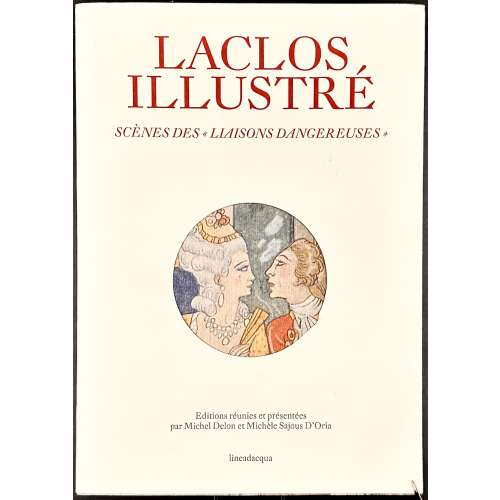 NEWSoftcover, 240 x 170 mm, creme dust jacket with red and black lettering and circular opening in the middle to front, red lettering to spine, over pictorial wrappers, pp. [1-8] 9-143 [1], ISBN 978-88-95598-25-3. 1st edition. Title-page (red and black): LACLOS | ILLUSTRE | « SCÈNES DES « LIAISONS DANGEREUSES» | Editions réunies et présentées | par Michel Delon et Michèle Sajous D'Oria | lineadacqua || Colophon: Imprimé à Venise, Italie | En février 2014 | Par Grafiche Veneziane || Publisher: Lineadacqua Edizioni; San Marco 3717/d, 30124 Venezia; www.lineadacqua.com Contributors: Michel Delon (French, b. 1947) – author Michèl Sajous D’Oria – author Contents: ILLUSTRATION ET INTERPRÉTATION – Michel Delon METTRE LES LETTRES ENSCÈNES – Michèle Sajous D'Oria LES LETTRES L'ÉCRITURE LE SECRET LA TRAHISON LE REFUS LA MARQUISE DE MERTEUIL LA PETITE MAISON LE CHEVALIER DE PRÉVAN LE RIVAL LE PIÈGE LE VICOMTE, DE VALMONT SÉDUCTIONS CÉCILE DE VOLANGES LA SURPRISE DES SENS LE VIOL LAPRÉSIDENTE DE TOURVEL L'AMOUR LA MORT FINALE Bibliographie des éditions illustrées Notices sur les illustrateurs
NEWSoftcover, 240 x 170 mm, creme dust jacket with red and black lettering and circular opening in the middle to front, red lettering to spine, over pictorial wrappers, pp. [1-8] 9-143 [1], ISBN 978-88-95598-25-3. 1st edition. Title-page (red and black): LACLOS | ILLUSTRE | « SCÈNES DES « LIAISONS DANGEREUSES» | Editions réunies et présentées | par Michel Delon et Michèle Sajous D'Oria | lineadacqua || Colophon: Imprimé à Venise, Italie | En février 2014 | Par Grafiche Veneziane || Publisher: Lineadacqua Edizioni; San Marco 3717/d, 30124 Venezia; www.lineadacqua.com Contributors: Michel Delon (French, b. 1947) – author Michèl Sajous D’Oria – author Contents: ILLUSTRATION ET INTERPRÉTATION – Michel Delon METTRE LES LETTRES ENSCÈNES – Michèle Sajous D'Oria LES LETTRES L'ÉCRITURE LE SECRET LA TRAHISON LE REFUS LA MARQUISE DE MERTEUIL LA PETITE MAISON LE CHEVALIER DE PRÉVAN LE RIVAL LE PIÈGE LE VICOMTE, DE VALMONT SÉDUCTIONS CÉCILE DE VOLANGES LA SURPRISE DES SENS LE VIOL LAPRÉSIDENTE DE TOURVEL L'AMOUR LA MORT FINALE Bibliographie des éditions illustrées Notices sur les illustrateurs -
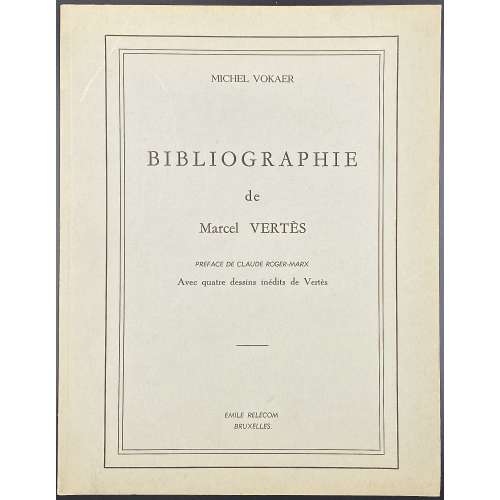 Description: Limited softcover edition in grey publisher’s wrappers 27 x 21 cm, lettered in a frame “MICHEL VOKAER | BIBLIOGRAPHIE | de | Marcel VERTÈS | PREFACE DE CLAUDE ROGER-MARX | Avec quatre dessins inédits de Vertès | — | EMILE RELECOM | BRUXELLES ||, lettered spine, pp. [1-4 h.t., t.p.] 5-34 [35, 36 blanks] [37 limitation] [38 blank] [39 colophon] [40 blank]; 40 pages total plus 4 photomechanical reproductions of Vertès’ unpublished drawings on glossy paper, extraneous to collation. Catalogue of 82 entries. Received uncut. Title-page: similar to front wrapper, plus «1967» in the bottom under BRUXELLES. Limitation: 7 copies (A-G) on Japon chamois + 2 suites of plates, 25 copies (1-25) on Hollande Van Gelder + 1 suite of plates, 450 copies (26-475) on offset Arduenna, and 40 copies not hor sale (I-XL) on different papers. The total print run is 522 copies, of which this is № 206. Ref: leslibraires.fr Contributors: Michel Vokaer (Belgian, 20th century) – author. Claude Roger-Marx (Jewish-French, 1888 – 1977) – author. Marcel Vertès [Marcell Vértes] (Jewish-Hungarian-French, 1895 – 1961) – artist. Xavier Gustave Emile Relecom (Belgian, 1900 – 1977) – publisher.
Description: Limited softcover edition in grey publisher’s wrappers 27 x 21 cm, lettered in a frame “MICHEL VOKAER | BIBLIOGRAPHIE | de | Marcel VERTÈS | PREFACE DE CLAUDE ROGER-MARX | Avec quatre dessins inédits de Vertès | — | EMILE RELECOM | BRUXELLES ||, lettered spine, pp. [1-4 h.t., t.p.] 5-34 [35, 36 blanks] [37 limitation] [38 blank] [39 colophon] [40 blank]; 40 pages total plus 4 photomechanical reproductions of Vertès’ unpublished drawings on glossy paper, extraneous to collation. Catalogue of 82 entries. Received uncut. Title-page: similar to front wrapper, plus «1967» in the bottom under BRUXELLES. Limitation: 7 copies (A-G) on Japon chamois + 2 suites of plates, 25 copies (1-25) on Hollande Van Gelder + 1 suite of plates, 450 copies (26-475) on offset Arduenna, and 40 copies not hor sale (I-XL) on different papers. The total print run is 522 copies, of which this is № 206. Ref: leslibraires.fr Contributors: Michel Vokaer (Belgian, 20th century) – author. Claude Roger-Marx (Jewish-French, 1888 – 1977) – author. Marcel Vertès [Marcell Vértes] (Jewish-Hungarian-French, 1895 – 1961) – artist. Xavier Gustave Emile Relecom (Belgian, 1900 – 1977) – publisher. -
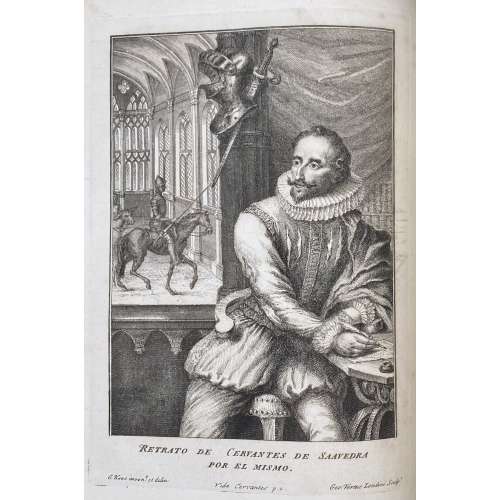 Two volumes uniformly bound by Riviere & Son in full red marbled calf, triple fillet border stamped in gilt, elaborate gilt ornament and brown morocco labels with gilt lettering to spine, all edge gilt, gilt dentelles. Vol. 1: Title page: THE | LIFE AND EXPLOITS | Of the ingenious gentleman | DON QUIXOTE | DE LA MANCHA. | Translated from the Original Spanish of | Miguel Cervantes de Saavedra. | By CHARLES JARVIS, Esq; | IN TWO VOLUMES. | {single rule} | VOLUME the FIRST. | {double rule} | LONDON: | Printed for J. and R. Tonson in the Strand, and | R. Dodsley in Pall-Mall. | {single rule} | M DCC XLII || Pagination: [i-iii] iv-xxxii, [i-iii] iv-vi, [2], [1] 2-90, [14], [1] 2-355 [356]; 500 pages total + ils. Collation: 4to; 250 leaves; A4 a-b4 c-d2, A4, a-l4 m2 n4 o2, B-Z4, Aa-Yy4 Z2, ils. Illustrations: 27 full-page copperplate engravings, incl. frontispiece (skillfully repaired), portrait of Cervantes by George Vertue After G. Kent and a fictional portrait of Don Quixote by George Vertue after John Vanderbank. Vol. 2: Title page: THE | LIFE AND EXPLOITS | Of the ingenious gentleman | DON QUIXOTE | DE LA MANCHA. | Translated from the Original Spanish of | Miguel Cervantes de Saavedra. | By CHARLES JARVIS, Esq; | {single rule} | VOLUME the SECOND. | {double rule} | LONDON: | Printed for J. and R. Tonson in the Strand, and | R. Dodsley in Pall-Mall. | {single rule} | M DCC XLII || Pagination: [i-iii] iv-xii, [1] 2-388; 400 pages total + ils. Collation: 4to; 200 leaves; A4 a2 B-Z4 Aa-Zz4 Aaa-Ccc4 Ddd2, ils. Illustrations:41 full-page copperplate engravings, pl. 29 (as frontispieces) precedes pl. 28. Contributors: Author: Miguel de Cervantes Saavedra (Spanish, 1547 – 1616) Translator: Charles Jervas (British, 1675 – 1739) Author: Cervantes biography by Gregorio Mayans y Siscar (Spanish, 1699 – 1781) Translator: Cervantes biography by John Ozell (British, d. 1743) Illustrator: John Vanderbank, the younger (British, 1694 – 1739) Artist: (Cervantes portrait): G. Kent (British, fl. 1738 – 1742) Engravers: Gerard Vandergucht (British, 1696 – 1776); George Vertue (British, 1684 – 1756); Bernard Baron (French, 1696 – 1762); Claude Du Bosc (French, 1682 – 1746 or later) Publishers: J. and R. Tonson (London); Robert Dodsley (British, 1703 – 1764) Catalogue raisonné: Lewine p. 102 Reference: Metropolitan Museum (New York)
Two volumes uniformly bound by Riviere & Son in full red marbled calf, triple fillet border stamped in gilt, elaborate gilt ornament and brown morocco labels with gilt lettering to spine, all edge gilt, gilt dentelles. Vol. 1: Title page: THE | LIFE AND EXPLOITS | Of the ingenious gentleman | DON QUIXOTE | DE LA MANCHA. | Translated from the Original Spanish of | Miguel Cervantes de Saavedra. | By CHARLES JARVIS, Esq; | IN TWO VOLUMES. | {single rule} | VOLUME the FIRST. | {double rule} | LONDON: | Printed for J. and R. Tonson in the Strand, and | R. Dodsley in Pall-Mall. | {single rule} | M DCC XLII || Pagination: [i-iii] iv-xxxii, [i-iii] iv-vi, [2], [1] 2-90, [14], [1] 2-355 [356]; 500 pages total + ils. Collation: 4to; 250 leaves; A4 a-b4 c-d2, A4, a-l4 m2 n4 o2, B-Z4, Aa-Yy4 Z2, ils. Illustrations: 27 full-page copperplate engravings, incl. frontispiece (skillfully repaired), portrait of Cervantes by George Vertue After G. Kent and a fictional portrait of Don Quixote by George Vertue after John Vanderbank. Vol. 2: Title page: THE | LIFE AND EXPLOITS | Of the ingenious gentleman | DON QUIXOTE | DE LA MANCHA. | Translated from the Original Spanish of | Miguel Cervantes de Saavedra. | By CHARLES JARVIS, Esq; | {single rule} | VOLUME the SECOND. | {double rule} | LONDON: | Printed for J. and R. Tonson in the Strand, and | R. Dodsley in Pall-Mall. | {single rule} | M DCC XLII || Pagination: [i-iii] iv-xii, [1] 2-388; 400 pages total + ils. Collation: 4to; 200 leaves; A4 a2 B-Z4 Aa-Zz4 Aaa-Ccc4 Ddd2, ils. Illustrations:41 full-page copperplate engravings, pl. 29 (as frontispieces) precedes pl. 28. Contributors: Author: Miguel de Cervantes Saavedra (Spanish, 1547 – 1616) Translator: Charles Jervas (British, 1675 – 1739) Author: Cervantes biography by Gregorio Mayans y Siscar (Spanish, 1699 – 1781) Translator: Cervantes biography by John Ozell (British, d. 1743) Illustrator: John Vanderbank, the younger (British, 1694 – 1739) Artist: (Cervantes portrait): G. Kent (British, fl. 1738 – 1742) Engravers: Gerard Vandergucht (British, 1696 – 1776); George Vertue (British, 1684 – 1756); Bernard Baron (French, 1696 – 1762); Claude Du Bosc (French, 1682 – 1746 or later) Publishers: J. and R. Tonson (London); Robert Dodsley (British, 1703 – 1764) Catalogue raisonné: Lewine p. 102 Reference: Metropolitan Museum (New York) -
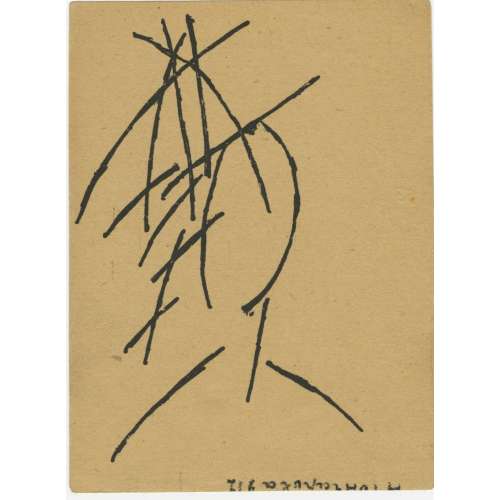 Artist: Mikhail Larionov (June 3, 1881 – May 10, 1964) ). Russian/French. Lithographic illustration "Woman in a hat" for Aleksei Kruchenykh book "Lipstick", Moscow, Kuzmin and Dolinsky Publishers, 1913, 480 copies printed. Size: 11,3 х 8,2 cm. Михаил Ларионов (3 июня 1881 – 10 мая 1964). Россия/Франция. Литографическая иллюстрация "Женщина в шляпе" к книге Алексея Крученых "Помада"; М.: Изд. Г.Л. Кузьмина и С.Д. Долинского, 1913, отпечатана в 480 экз. Формат: 11,3 х 8,2 см.
Artist: Mikhail Larionov (June 3, 1881 – May 10, 1964) ). Russian/French. Lithographic illustration "Woman in a hat" for Aleksei Kruchenykh book "Lipstick", Moscow, Kuzmin and Dolinsky Publishers, 1913, 480 copies printed. Size: 11,3 х 8,2 cm. Михаил Ларионов (3 июня 1881 – 10 мая 1964). Россия/Франция. Литографическая иллюстрация "Женщина в шляпе" к книге Алексея Крученых "Помада"; М.: Изд. Г.Л. Кузьмина и С.Д. Долинского, 1913, отпечатана в 480 экз. Формат: 11,3 х 8,2 см. -
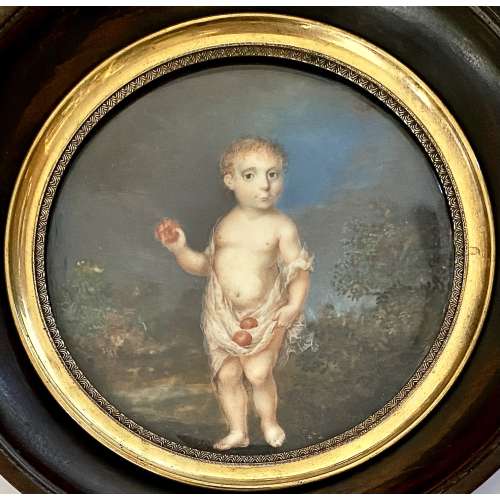 Round portrait of a little girl (22-month-old) with bright black eyes and red hair, draped in a semi-transparent shirt which leaves her chest and stomach bare, keeping a red apple in her right hand and two others lying in the fold of her clothes, standing against a dark natural background: bushes, leaves, an apple tree, blue skies, clouds, etc. Oil on metal; in an ormolu frame, in a wooden frame. Diameter without frames 8 cm, with frames – 12.6 cm. Sitter: Courtois, Fortunée-Florentine Elisabeth (French, August 23, 1800 г. – after 1878). Inscription (handwriting, nut ink): Fortunée, Florentine Elisabeth | Courtois a 22 mois. | née 5e fructidor an 8 || Attributed to Lié Louis Périn-Salbreux (French, 1753 – 1817). Fortunée-Florentine Elisabeth Courtois is a mother of Maurice Joly (French, 1829 – 1878). See also in this collection: blog, LIB-0460, blog, LIB-1038.2016, and Une Épave de l’Ancien Bateau by Tout-Paris. A Lost Article by Proust? The portrait was sold at Drouot (Paris) in 2020 with the following description: "École FRANÇAISE de la fin du XVIIIe siècle Fortunée Florentine Courtois enfant en chemise, en pied dans la nature, tenant trois pommes. Miniature sur ivoire, identifiée au revers : « Florentine Fortunée Elisabeth / Courtois à 22 mois / le 5e ( ?) Fructidor an VIII » [août 1800]; Diam. à vue : 7 cm; Cadre rond en bois tourné et noirci. Florentine Courtois, fille d’André et d’Elisabeth Corbara, épousa vers 1818 Lambert Philippe Joly, conseiller général du Jura, avocat ; leur fils Maurice Joly, avocat, fut ministre de la Justice du gouvernement provisoire en 1870 et grand maître du Grand Orient de France". Maurice Joly was a lawyer, but nothing else in his description given by Drouot is true. From this inscription, we learned that Fortunée-Florentine Elisabeth Courtois was born on August 23, 1800. We were unable to verify this from any other source. From Morice Joly autobiography (Maurice Joly, son passé, son programme par lui-même. — Paris, Lacroix, Verbœckoven et Ce, 1870) we know that she was born in Bastia and that her father, Laurent Courtois (in some sources André François Désiré Courtois, born c. 1771), was a treasurer of Corsican troops under Napoleon Bonapart. Her mother was Elisabeth Marie-Grâcieuse Corbara (born c. 1750).
Round portrait of a little girl (22-month-old) with bright black eyes and red hair, draped in a semi-transparent shirt which leaves her chest and stomach bare, keeping a red apple in her right hand and two others lying in the fold of her clothes, standing against a dark natural background: bushes, leaves, an apple tree, blue skies, clouds, etc. Oil on metal; in an ormolu frame, in a wooden frame. Diameter without frames 8 cm, with frames – 12.6 cm. Sitter: Courtois, Fortunée-Florentine Elisabeth (French, August 23, 1800 г. – after 1878). Inscription (handwriting, nut ink): Fortunée, Florentine Elisabeth | Courtois a 22 mois. | née 5e fructidor an 8 || Attributed to Lié Louis Périn-Salbreux (French, 1753 – 1817). Fortunée-Florentine Elisabeth Courtois is a mother of Maurice Joly (French, 1829 – 1878). See also in this collection: blog, LIB-0460, blog, LIB-1038.2016, and Une Épave de l’Ancien Bateau by Tout-Paris. A Lost Article by Proust? The portrait was sold at Drouot (Paris) in 2020 with the following description: "École FRANÇAISE de la fin du XVIIIe siècle Fortunée Florentine Courtois enfant en chemise, en pied dans la nature, tenant trois pommes. Miniature sur ivoire, identifiée au revers : « Florentine Fortunée Elisabeth / Courtois à 22 mois / le 5e ( ?) Fructidor an VIII » [août 1800]; Diam. à vue : 7 cm; Cadre rond en bois tourné et noirci. Florentine Courtois, fille d’André et d’Elisabeth Corbara, épousa vers 1818 Lambert Philippe Joly, conseiller général du Jura, avocat ; leur fils Maurice Joly, avocat, fut ministre de la Justice du gouvernement provisoire en 1870 et grand maître du Grand Orient de France". Maurice Joly was a lawyer, but nothing else in his description given by Drouot is true. From this inscription, we learned that Fortunée-Florentine Elisabeth Courtois was born on August 23, 1800. We were unable to verify this from any other source. From Morice Joly autobiography (Maurice Joly, son passé, son programme par lui-même. — Paris, Lacroix, Verbœckoven et Ce, 1870) we know that she was born in Bastia and that her father, Laurent Courtois (in some sources André François Désiré Courtois, born c. 1771), was a treasurer of Corsican troops under Napoleon Bonapart. Her mother was Elisabeth Marie-Grâcieuse Corbara (born c. 1750). -
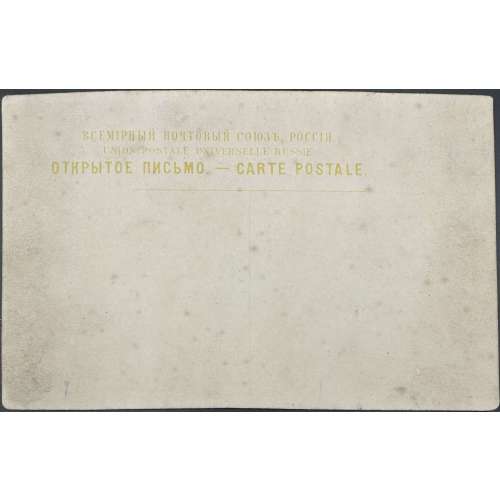 Ten postcards 90 x 140 mm, text in yellow "ВСЕМIРНЫЙ ПОЧТОВЫЙ СОЮЗЪ. РОССIЯ. | UNION POSTALE UNIVERSELLE RUSSIE. | ОТКРЫТОЕ ПИСЬМО. — CARTE POSTALE. || On the reverse, a blue ink woodcut image is printed in the upper left corner, and a blue ink numbered image title is in the bottom centre. Holding the postcard against the backlight reveals a hidden image of an indecent nature (erotic). The use of Latin characters "R" and "N" instead of Russian "Р" and "Н" suggests that the cards were produced in Europe, probably in France. Inscriptions: 1. ПЕRВЫЕ ДNИ; 2. ПОRА ЛЮБВИ; 3. ВЪ ЛЮДИ; 4. КЪ "СВОБОДNОМУ ИСКУССТВУ"; 5. "СВОБОДNЫЙ ТRУДЪ; 6. БЕЗЪ ГОRЯ И ПЕЧАЛИ; 7. NАЗАДЪ КЪ "СВОБОДNОЙ ЛЮБВИ"; 8. ВСЕ ЧТО ОСТАЛОСЬ!; 9. БЕЗЪ КRОВА И ПRИСТАNИЩА; 10. ИЗЪ ЗА ХЛѢБА.
Ten postcards 90 x 140 mm, text in yellow "ВСЕМIРНЫЙ ПОЧТОВЫЙ СОЮЗЪ. РОССIЯ. | UNION POSTALE UNIVERSELLE RUSSIE. | ОТКРЫТОЕ ПИСЬМО. — CARTE POSTALE. || On the reverse, a blue ink woodcut image is printed in the upper left corner, and a blue ink numbered image title is in the bottom centre. Holding the postcard against the backlight reveals a hidden image of an indecent nature (erotic). The use of Latin characters "R" and "N" instead of Russian "Р" and "Н" suggests that the cards were produced in Europe, probably in France. Inscriptions: 1. ПЕRВЫЕ ДNИ; 2. ПОRА ЛЮБВИ; 3. ВЪ ЛЮДИ; 4. КЪ "СВОБОДNОМУ ИСКУССТВУ"; 5. "СВОБОДNЫЙ ТRУДЪ; 6. БЕЗЪ ГОRЯ И ПЕЧАЛИ; 7. NАЗАДЪ КЪ "СВОБОДNОЙ ЛЮБВИ"; 8. ВСЕ ЧТО ОСТАЛОСЬ!; 9. БЕЗЪ КRОВА И ПRИСТАNИЩА; 10. ИЗЪ ЗА ХЛѢБА. -
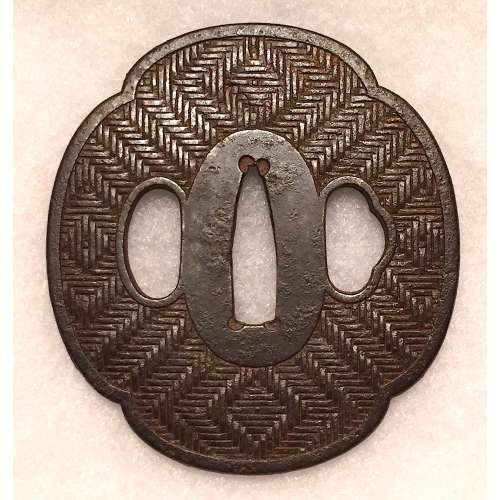 Iron tsuba with brown patina in mokkō-gata form with woven design. Size: 72 x 67 x 5 mm.
Iron tsuba with brown patina in mokkō-gata form with woven design. Size: 72 x 67 x 5 mm. -
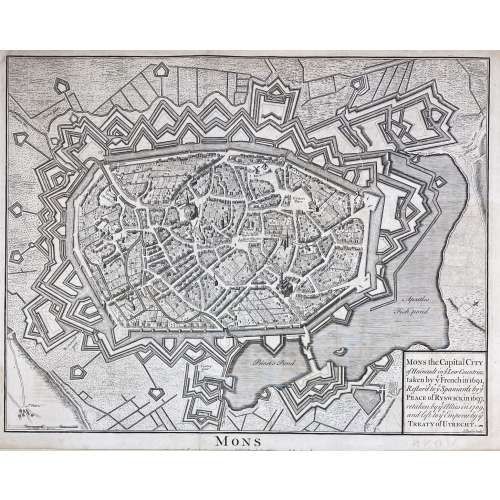
Mons the Capital City of Hainault in y Low Countries, taken by y French in 1691, Restor'd to y Spaniards by y Peace of Ryswick in 1697, retaken by y Allies in 1709, and left to y Emperor by y Treaty of Utrecht. attribution to publication source has been trimmed.
Dimensions: Sheet: 40.7 x 52.5 cm; Image: 37.5 x 48 cm. Published between 1744 and 1747. Attribution to publication source has been trimmed. Reference: Royal Academy 03/2919. Source: Maps for Mr. Tindal's Continuation of Mr. Rapin's History of England. London: John and Paul Knapton. Nicolas Tindal (British, 1687 – 1774) – the translator and continuer of the History of England by Paul de Rapin. Paul de Rapin (French, 1661 – 1725) – a Huguenot historian, author of the History of England. -
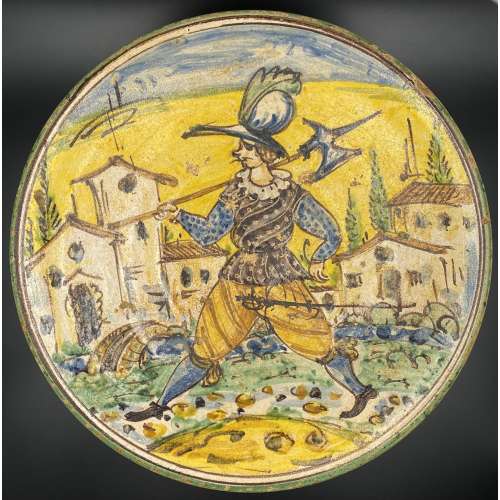 Footed round dish depicting a gentleman in an urban landscape holding a halberd in a style of "Arlecchino di Montelupo". Unsigned. Chips to the bottom. Diameter: 32.5 cm; Height: 4.5 cm. Produced in Italy, in Montelupo, about 20 kilometres (12 miles) southwest of Florence. 17th century, probably the first half. "After 1630, the year of the great plague, the number of potters reduced considerably and in the second half of the 1600s production suffered a drastic slump, potteries that specialized in a more prestigious production disappeared completely leaving only the potteries that produced kitchenware and terracotta objects" [www.tuscany-charming.it].
Footed round dish depicting a gentleman in an urban landscape holding a halberd in a style of "Arlecchino di Montelupo". Unsigned. Chips to the bottom. Diameter: 32.5 cm; Height: 4.5 cm. Produced in Italy, in Montelupo, about 20 kilometres (12 miles) southwest of Florence. 17th century, probably the first half. "After 1630, the year of the great plague, the number of potters reduced considerably and in the second half of the 1600s production suffered a drastic slump, potteries that specialized in a more prestigious production disappeared completely leaving only the potteries that produced kitchenware and terracotta objects" [www.tuscany-charming.it]. -
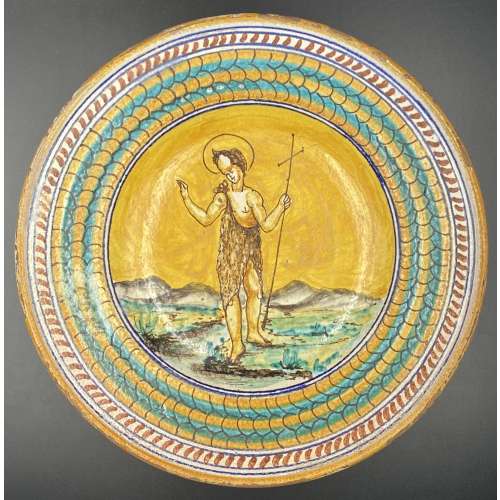 Tin-glazed earthenware polychrome plate of round form, decorated with a figure of John the Baptist wearing clothes of camel's hair with a tall cross in his left hand and with a halo over his head, walking in a desert with hills on the background. The lip is decorated with circles and scales, base with concentric circles. Diameter: 23 cm; Height: 4 cm.
Tin-glazed earthenware polychrome plate of round form, decorated with a figure of John the Baptist wearing clothes of camel's hair with a tall cross in his left hand and with a halo over his head, walking in a desert with hills on the background. The lip is decorated with circles and scales, base with concentric circles. Diameter: 23 cm; Height: 4 cm. -
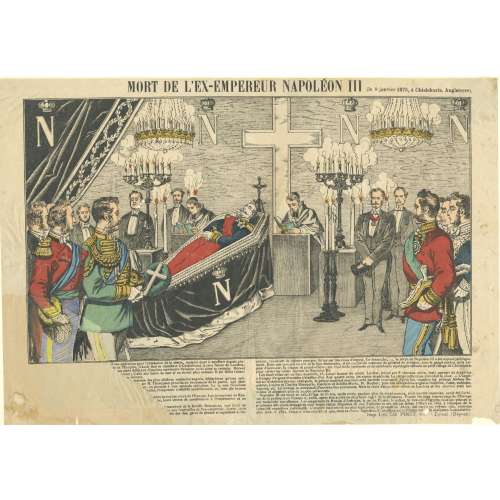 Hand-coloured woodcut on wove paper, 270 x 380 mm; attached to the sheet 303 x 442 mm with pencil ms inscription to the top left corner on the reverse: “Haye le 2-3-75”. Top: "MORT DE L'EX-EMPEREUR NAPOLÉON III (le 9 janvier 1873, à Chislehurts [sic], Angleterre)." Bottom right: "Imp. Lith. CH. PINOT, éditeur. Épinal (Dépose)". Bottom left corner of the image sheet torn and manually restored. Text partially lost, starting with « d’une opération pour l’extraction de la pierre, maladie dont’ il souffrait depuis plu-… ». See Chislehurst. Charles-François Pinot (French, 1817 – 1879) – publisher/printer.
Hand-coloured woodcut on wove paper, 270 x 380 mm; attached to the sheet 303 x 442 mm with pencil ms inscription to the top left corner on the reverse: “Haye le 2-3-75”. Top: "MORT DE L'EX-EMPEREUR NAPOLÉON III (le 9 janvier 1873, à Chislehurts [sic], Angleterre)." Bottom right: "Imp. Lith. CH. PINOT, éditeur. Épinal (Dépose)". Bottom left corner of the image sheet torn and manually restored. Text partially lost, starting with « d’une opération pour l’extraction de la pierre, maladie dont’ il souffrait depuis plu-… ». See Chislehurst. Charles-François Pinot (French, 1817 – 1879) – publisher/printer. -
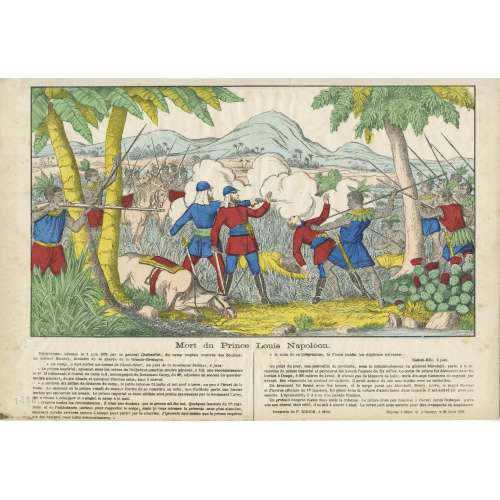 Hand-coloured woodcut on wove paper, 267 x 390 mm. On reverse: black ink stamp “5351”. Centre, under the image frame "Mort du Prince Louis Napoléon". Below left: "Télégramme adressé le 2 juin 1879 par le général Chelmsfort, du camp anglais (contrée des Zoulous), au colonel Stanley, ministre de la guerre de la Grande-Bretagne. « Au camp, à sept milles au-dessus de Blood-River, au pied de la montagne Stellezi, 2 juin: Le prince impérial, agissant sous les ordres de l'adjudant quartier-maitre général. a fait une reconnaissance le 1er. Il retournait à cheval au camp le 2 accompagné du lieutenant Carey, du 98e adjudant en second du quartier-maitre général. de six blancs et, quelques Zoulous amis, tous à cheval. A environ dix milles de distance du camp, la petite colonne fit halte at mit pied à terre, un peu à l’écart de la route. Au moment ou le prince venait de donner l'ordre de se remettre en selle. une fusillade partit des hautes herbes qui entourant les kraals. Le prince impérial et deux soldats sont portés manquants par le lieutenant Carey, qui a réussi à échapper et a gagné le camp à la nuit. D'après toutes les circonstances, il 'est pas douteux quo le prince ait été tué. Quelques lanciers du 17 régiment et de l'ambulance partent pour rapporter le corps; mais je vous adresse la présente sans plus attendre, espérant qu'elle arrivera encore à temps pour partir par le courrier. J’ignorais moi-même que le prince impérial eût été désigné pour cette reconnaissance. »" Below right: A la suite de le télégramme, le Times publie les dépêches suivantes: Stelezi-Hill, 2 juin. Au point du jour, une patrouille de cavalerie, sous le commandement du général Marshall. partit à la recherche du prince impérial et parcourut les kraals l'espace de dix milles. Le corps du prince fut découvert dans les herbes à Donga, à 300 mètres du kraal. Il n'avait pas de blessure de balle, mais dix-sept blessures de zagaies par devant. Ses vêtements lui avaient été enlevés. I avait autour du cou une chaine avec un médaillon. Un brancard fut formé avec les lances, et le corps porté par Marchall, Drury, Lowe, le mjor Stewart et d'autres officiers du 17e lanciers, fut. place dans la voiture d'ambulance dans laquelle il est arrivé ici avec une escorte. L'après-midi, il v a eu une parade funèbre. Un profond chagrin règne dans toute la colonne. Le prince n'est pas remonté à cheval après l’attique, parce que son cheval était rétif ; il se mit à courir à pied. Le corps part sous escorte pour être transporté en Angleterre. Bottom right: "Imagerie de P. DIDION, à Metz — Déposé à Metz et à Nancy, le 25 Juin 1879". Paulin Didion (French, 1831 – 1879) – publisher/printer.
Hand-coloured woodcut on wove paper, 267 x 390 mm. On reverse: black ink stamp “5351”. Centre, under the image frame "Mort du Prince Louis Napoléon". Below left: "Télégramme adressé le 2 juin 1879 par le général Chelmsfort, du camp anglais (contrée des Zoulous), au colonel Stanley, ministre de la guerre de la Grande-Bretagne. « Au camp, à sept milles au-dessus de Blood-River, au pied de la montagne Stellezi, 2 juin: Le prince impérial, agissant sous les ordres de l'adjudant quartier-maitre général. a fait une reconnaissance le 1er. Il retournait à cheval au camp le 2 accompagné du lieutenant Carey, du 98e adjudant en second du quartier-maitre général. de six blancs et, quelques Zoulous amis, tous à cheval. A environ dix milles de distance du camp, la petite colonne fit halte at mit pied à terre, un peu à l’écart de la route. Au moment ou le prince venait de donner l'ordre de se remettre en selle. une fusillade partit des hautes herbes qui entourant les kraals. Le prince impérial et deux soldats sont portés manquants par le lieutenant Carey, qui a réussi à échapper et a gagné le camp à la nuit. D'après toutes les circonstances, il 'est pas douteux quo le prince ait été tué. Quelques lanciers du 17 régiment et de l'ambulance partent pour rapporter le corps; mais je vous adresse la présente sans plus attendre, espérant qu'elle arrivera encore à temps pour partir par le courrier. J’ignorais moi-même que le prince impérial eût été désigné pour cette reconnaissance. »" Below right: A la suite de le télégramme, le Times publie les dépêches suivantes: Stelezi-Hill, 2 juin. Au point du jour, une patrouille de cavalerie, sous le commandement du général Marshall. partit à la recherche du prince impérial et parcourut les kraals l'espace de dix milles. Le corps du prince fut découvert dans les herbes à Donga, à 300 mètres du kraal. Il n'avait pas de blessure de balle, mais dix-sept blessures de zagaies par devant. Ses vêtements lui avaient été enlevés. I avait autour du cou une chaine avec un médaillon. Un brancard fut formé avec les lances, et le corps porté par Marchall, Drury, Lowe, le mjor Stewart et d'autres officiers du 17e lanciers, fut. place dans la voiture d'ambulance dans laquelle il est arrivé ici avec une escorte. L'après-midi, il v a eu une parade funèbre. Un profond chagrin règne dans toute la colonne. Le prince n'est pas remonté à cheval après l’attique, parce que son cheval était rétif ; il se mit à courir à pied. Le corps part sous escorte pour être transporté en Angleterre. Bottom right: "Imagerie de P. DIDION, à Metz — Déposé à Metz et à Nancy, le 25 Juin 1879". Paulin Didion (French, 1831 – 1879) – publisher/printer. -
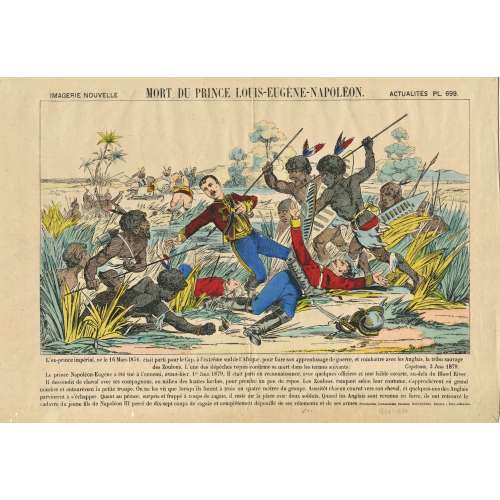 Hand-coloured lithography on wove paper, 275 x 385 mm; vertical centerfold, image in frame. On reverse: black ink stamp “5350”. Above the frame: "IMAGERIE NOUVELLE — MORT DU PRINCE LOUIS-EUGÈNE-NAPOLÉON. — ACTUALITÉS PL. 699". Under the frame: "L'ex-prince impérial, né le 16 Mars I856, était parti pour le Cap, à l'extrême sud de l'Afrique, pour faire son apprentissage de guerre, et combattre avec les Anglais, la tribu sauvage des Zoulous. L'une des dépêches reçues confirme sa mort dans les termes suivants: — Capetown, 3 Juin 1879. — Le prince Napoléon-Eugène a été tué à l'ennemi, avant-hier, 1er Juin 1879, Il était parti en reconnaissance, avec quelques officiers et une fable escorte, au-delà du Blood River. Il descendit de cheval ave ses compagnons, au milieu des hautes herbes, pour prendre un peu de repos. Les Zoulous, rampant selon leur coutume, s'approchèrent en grand nombre et entourèrent la petite troupe. On ne les vit que lorsqu' ils furent à trois ou quatre mètres du groupe. Aussitôt chacun court vers son cheval, et quelques-uns des Anglais parvinrent à s'échapper. Quant au prince, surpris et frappé à coups de zagaie, il resta sur la place avec deux soldats. Quand les Anglais sont revenus en force, ils ont retrouvé le cadavre du jeune fils de Napoléon III percé de dix-sept coups de zagaie et complétement dépouillé de ses vêtements et de ses armes". — "Typographie, Lithographie, Imagerie, Haguenthal, Éditeur à Pont-à-Mousson". Pencil ms: "1860-1880". Élie Haguenthal (French, 1822 – 1881) – publisher/printer.
Hand-coloured lithography on wove paper, 275 x 385 mm; vertical centerfold, image in frame. On reverse: black ink stamp “5350”. Above the frame: "IMAGERIE NOUVELLE — MORT DU PRINCE LOUIS-EUGÈNE-NAPOLÉON. — ACTUALITÉS PL. 699". Under the frame: "L'ex-prince impérial, né le 16 Mars I856, était parti pour le Cap, à l'extrême sud de l'Afrique, pour faire son apprentissage de guerre, et combattre avec les Anglais, la tribu sauvage des Zoulous. L'une des dépêches reçues confirme sa mort dans les termes suivants: — Capetown, 3 Juin 1879. — Le prince Napoléon-Eugène a été tué à l'ennemi, avant-hier, 1er Juin 1879, Il était parti en reconnaissance, avec quelques officiers et une fable escorte, au-delà du Blood River. Il descendit de cheval ave ses compagnons, au milieu des hautes herbes, pour prendre un peu de repos. Les Zoulous, rampant selon leur coutume, s'approchèrent en grand nombre et entourèrent la petite troupe. On ne les vit que lorsqu' ils furent à trois ou quatre mètres du groupe. Aussitôt chacun court vers son cheval, et quelques-uns des Anglais parvinrent à s'échapper. Quant au prince, surpris et frappé à coups de zagaie, il resta sur la place avec deux soldats. Quand les Anglais sont revenus en force, ils ont retrouvé le cadavre du jeune fils de Napoléon III percé de dix-sept coups de zagaie et complétement dépouillé de ses vêtements et de ses armes". — "Typographie, Lithographie, Imagerie, Haguenthal, Éditeur à Pont-à-Mousson". Pencil ms: "1860-1880". Élie Haguenthal (French, 1822 – 1881) – publisher/printer. -
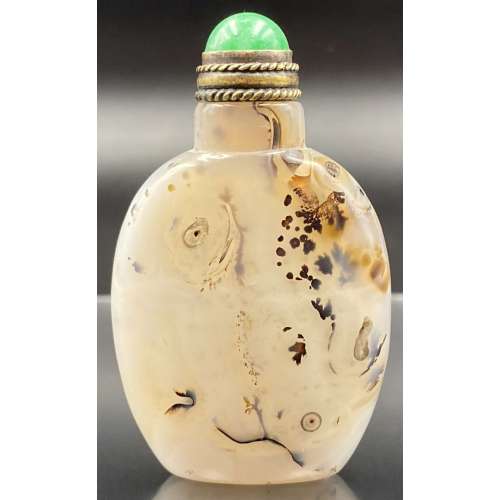 Agate snuff bottle of flattened rounded rectangular form, round neck, and flat base, semitransparent milky white body with dark brown inclusions of geometric form. Green jadeite stopper with a copper alloy spoon and collar. Qing dynasty [清] (1644-1912) Size: 7.2 x 4.3 x 2.2 cm
Agate snuff bottle of flattened rounded rectangular form, round neck, and flat base, semitransparent milky white body with dark brown inclusions of geometric form. Green jadeite stopper with a copper alloy spoon and collar. Qing dynasty [清] (1644-1912) Size: 7.2 x 4.3 x 2.2 cm -
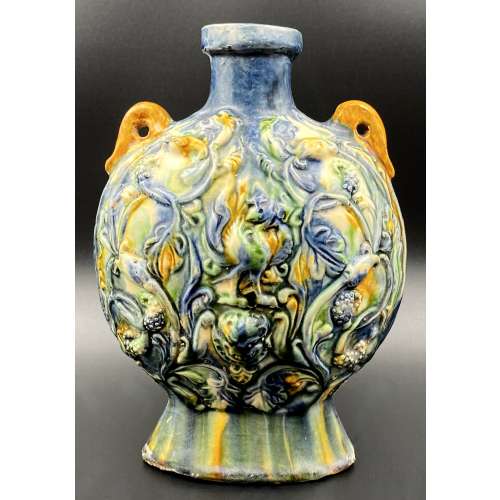 A vessel of flattened ovoid form supported on a tall splayed foot and surmounted by a short neck with the galleried rim. The shoulders set with a pair of loop handles, the body moulded on both sides with a Phenix surrounded with meandering floral and foliate scrolls. Covered with irregular splashes of green, amber, cream, and blue glazes, dripping down the foot. Foot bottom unglazed (beige body). China, the Tang dynasty [唐朝] (618 – 907). Height: 18.5 cm; Width: 13 cm
A vessel of flattened ovoid form supported on a tall splayed foot and surmounted by a short neck with the galleried rim. The shoulders set with a pair of loop handles, the body moulded on both sides with a Phenix surrounded with meandering floral and foliate scrolls. Covered with irregular splashes of green, amber, cream, and blue glazes, dripping down the foot. Foot bottom unglazed (beige body). China, the Tang dynasty [唐朝] (618 – 907). Height: 18.5 cm; Width: 13 cm -
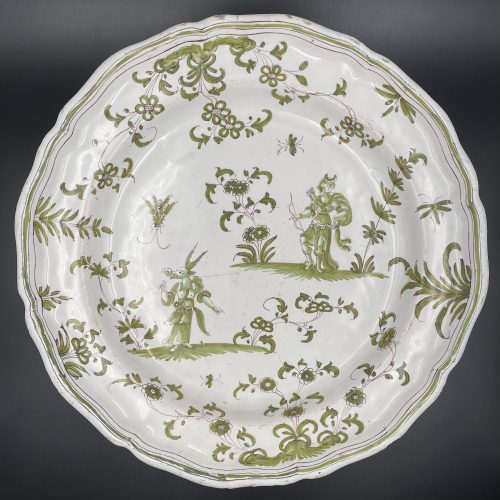 Moustiers faience plate: tin-glazed earthenware plate with a scalloped rim, with green monochrome grotesque decoration of a whimsical creature and a female archer, surrounded by flowering vegetation and insects. Marked "X" on the bottom. "Joseph Fouque/Jean-Francois Pelloquin, started in 1749, used an"X" in its pottery mark". Diameter: 31 cm; Height: 4 cm.
Moustiers faience plate: tin-glazed earthenware plate with a scalloped rim, with green monochrome grotesque decoration of a whimsical creature and a female archer, surrounded by flowering vegetation and insects. Marked "X" on the bottom. "Joseph Fouque/Jean-Francois Pelloquin, started in 1749, used an"X" in its pottery mark". Diameter: 31 cm; Height: 4 cm. -
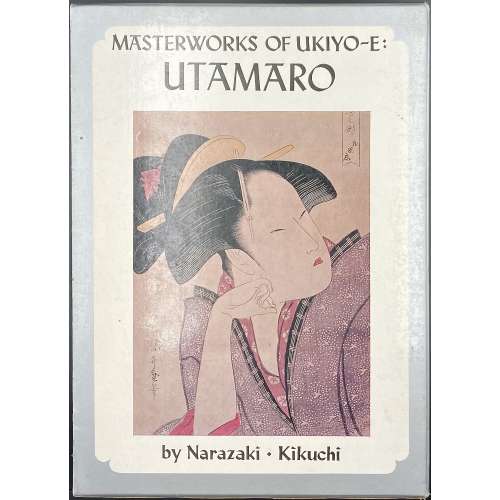 Hardcover volume from the series Masterworks of ukiyo-e, 26.5 x 19 cm, bound in unprimed canvas, red ms characters on black strip to front, red and black lettering to spine, tan embossed endpapers, in a pictorial slipcase with series design (black lettering on silver spine); pp: [1-6]: h.t./frontis. (colour plate pasted in), t.p./imprint, contents/acknowledgements), 7-31 text, [32] blank, 33-96 (76 plates w/captions). Title-page (in frame): MASTERWORKS OF UKIYO-E | UTAMARO | by Muneshige Narazaki and Sadao Kikuchi | Translated by John Bester | {publisher’s device} | KODANSHA INTERNATIONAL LTD. | Tokyo, Japan & Palo-Alto, Calif., U.S.A | {vertical, between rules 歌麿} || Series: Masterworks of ukiyo-e, № 4. Contributors: Muneshige Narazaki [楢崎 宗重] (Japanese, 1904 – 2001) – author. Sadao Kikuchi [菊地 貞雄] (Japanese, 1924 – 2017) – author. John Bester (British, 1927 – 2010) – translator. Kitagawa Utamaro [喜多川 歌麿] (Japanese, c. 1753 – 1806) – artist.
Hardcover volume from the series Masterworks of ukiyo-e, 26.5 x 19 cm, bound in unprimed canvas, red ms characters on black strip to front, red and black lettering to spine, tan embossed endpapers, in a pictorial slipcase with series design (black lettering on silver spine); pp: [1-6]: h.t./frontis. (colour plate pasted in), t.p./imprint, contents/acknowledgements), 7-31 text, [32] blank, 33-96 (76 plates w/captions). Title-page (in frame): MASTERWORKS OF UKIYO-E | UTAMARO | by Muneshige Narazaki and Sadao Kikuchi | Translated by John Bester | {publisher’s device} | KODANSHA INTERNATIONAL LTD. | Tokyo, Japan & Palo-Alto, Calif., U.S.A | {vertical, between rules 歌麿} || Series: Masterworks of ukiyo-e, № 4. Contributors: Muneshige Narazaki [楢崎 宗重] (Japanese, 1904 – 2001) – author. Sadao Kikuchi [菊地 貞雄] (Japanese, 1924 – 2017) – author. John Bester (British, 1927 – 2010) – translator. Kitagawa Utamaro [喜多川 歌麿] (Japanese, c. 1753 – 1806) – artist.


